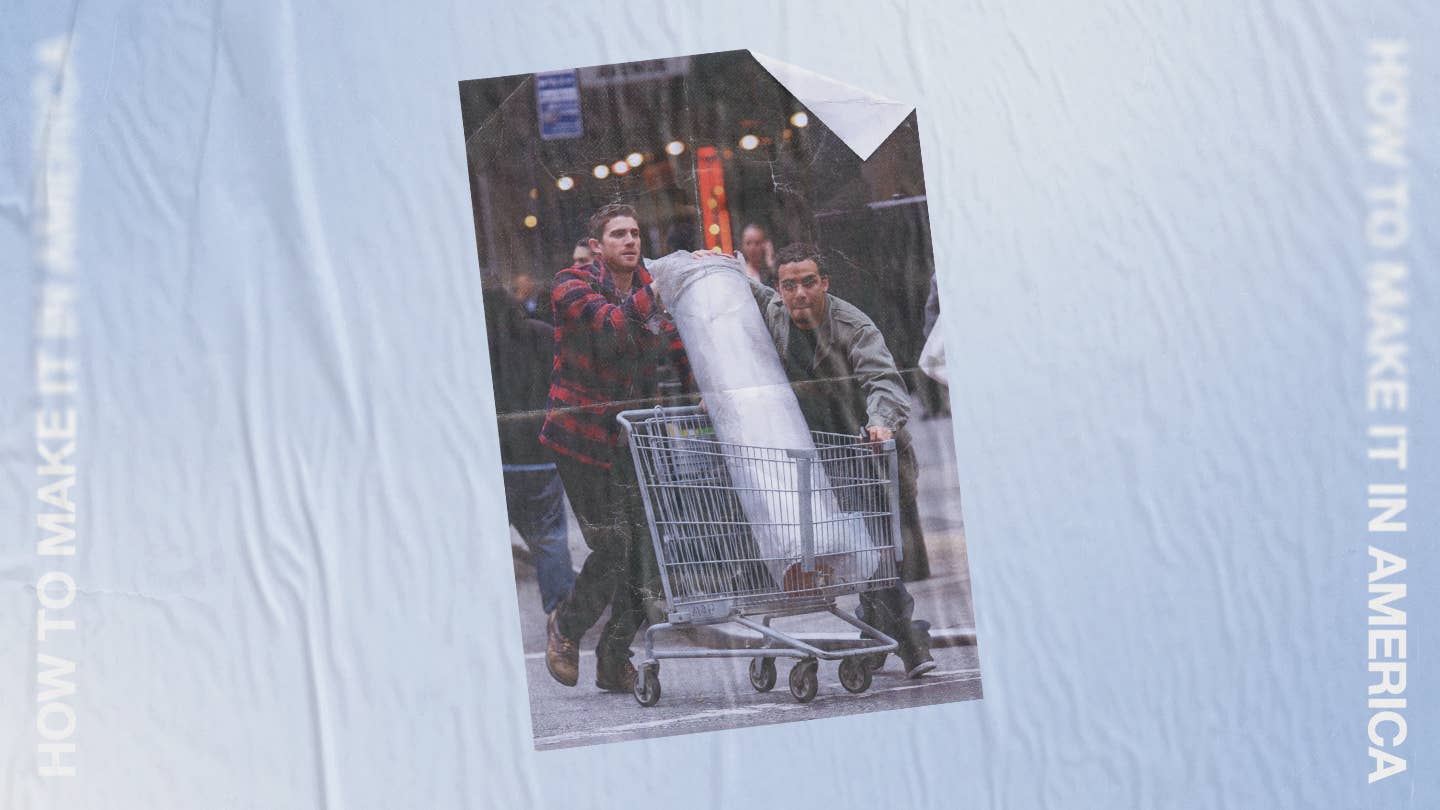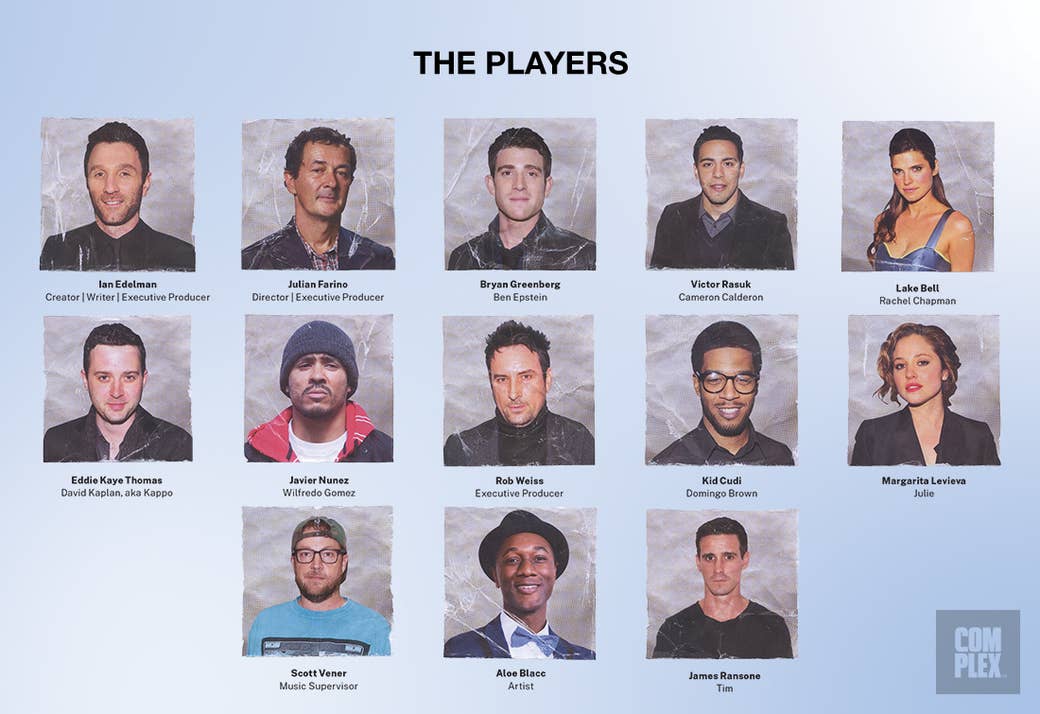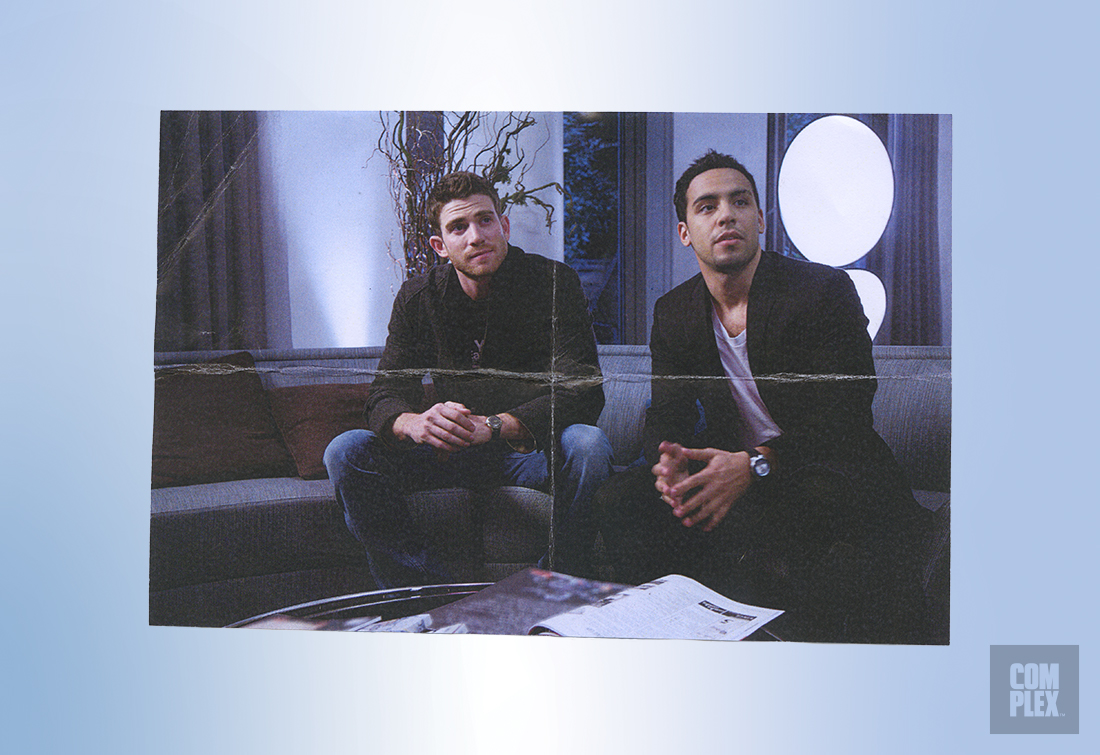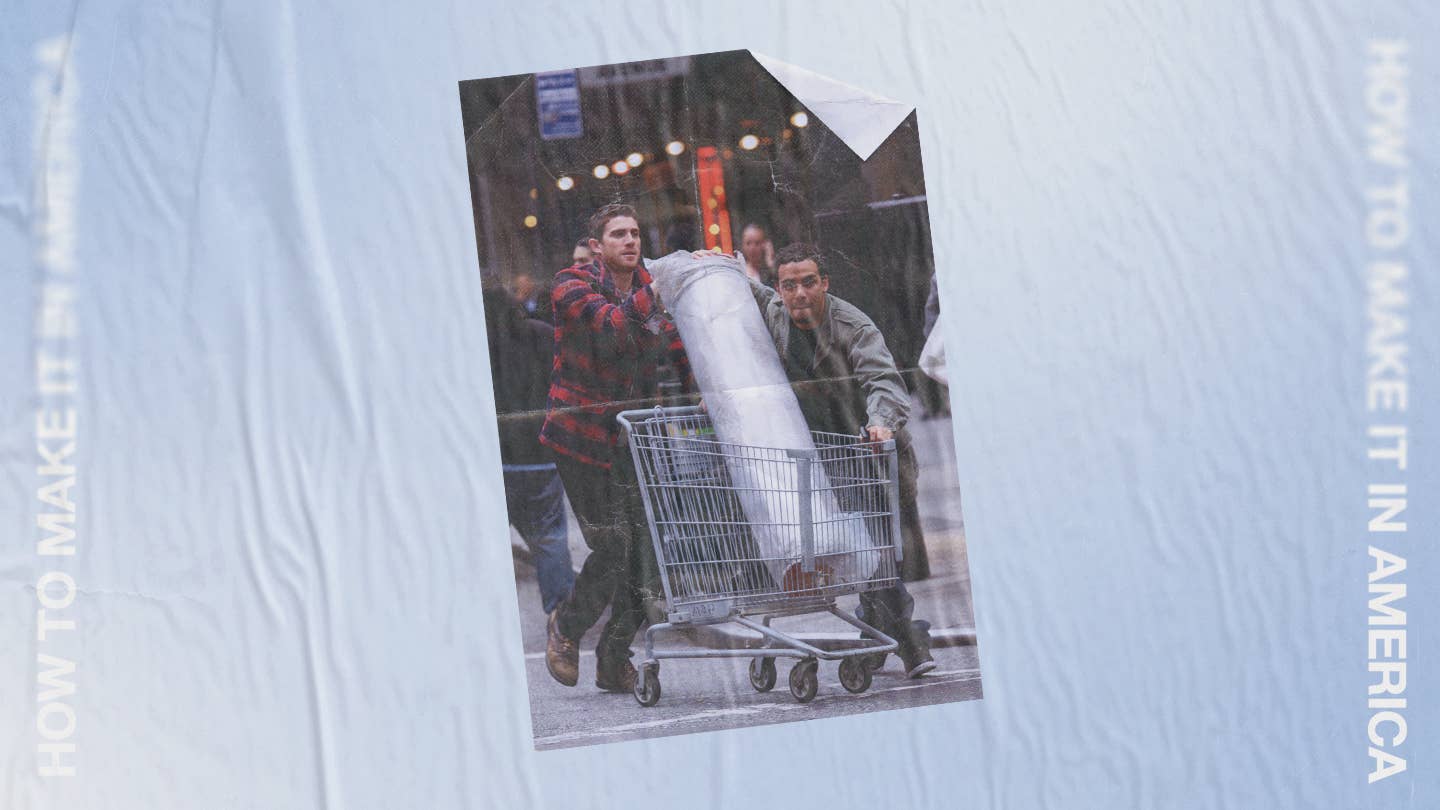
The late 2000s: They were the best of times, they were the absolute worst of times.
Although this period marked the glory days of the oft-romanticized blog era and a time before Karmaloop’s Chapter 11 filing and revival, it also saw the playbook for an entire way of life rewritten by the recession. Imbued with the optimism of Barack Obama’s historic presidential election in 2008, many resolved to figure it out by betting on themselves—existential dread and all. How to Make It in America, which premiered on HBO in February 2010, was guided by this spirit.
Created by writer/producer/director Ian Edelman, How to Make It in America peered into the lives of 20-somethings sorting through the mess in New York City at the turn of the decade. Ben Epstein (Bryan Greenberg) was the moody artist who couldn’t get out of his own way. Cameron Calderon (Victor Rasuk) was a natural hustler and the yin to Ben’s yang. On a “fuck it” impulse, the duo founded a clothing brand, Crisp, which was inspired by 1970s New York City.
How to Make It in America was certainly not for everyone. GQ cut it down for signaling “cool” without earning the distinction. A HuffPost critique frankly dismissed it as “a gimmick.” Criticism notwithstanding, How to Make It in Americaresonated with kindred spirits, as many related to the insatiable desire to “make it” in myriad ways. HBO gave it a second season featuring a bigger budget, a wider purview, and higher stakes. There were more famous guest stars and high-profile cameos (Pharrell; Isaac Mizrahi; Pusha-T), but, above all, improved storylines and structure.
And just like that, it was gone.
HBO sent How to Make It in America to the gallows in December 2011, canceling it a month after the second season concluded. The cast has since joined fans in calling for a revival of some sort, as both the people responsible for making the show and the audience it captured seek closure. Did Ben remain his own worst enemy? Did the industry leave Cam jaded? Did Crisp survive the 2010s? Maybe we’ll get these answers one day, maybe we won’t. In the meantime, here’s the next best thing: The story of How to Make It in America, as told by the people who made it.

The Beginning
Ian Edelman (creator, writer, executive producer): I was new to the whole business, and I didn’t really think about ideas that were sellable or the climate in the business of television. It was just, “This is what I think is cool. This is a show that doesn’t exist that I’d wanna watch. And this is a world that I know firsthand that I wanna write about.” That was really the jump-off, specifically me having an idea for a show about ambition and aspiration, and setting it in downtown New York City.
Julian Farino (director, executive producer): Casting is about chemistry, so, at the beginning, the show was being conceived as about a triangle of friends, which included Gingy. So we were looking for three parts. But the main dynamic between friends was Ben and Cam, so as much as we were thinking of everyone individually, we were also thinking of them as a duo.
Bryan Greenberg (Ben Epstein): I just read the script and I was like, “Is this a show or not?” I liked it, but I couldn’t tell if it was a show. It was unconventional; it was just a vibe. It wasn’t really plot-driven, but it had characters that you liked, in a world that I already knew because I spent a lot of time in New York, so I got it. It felt very right for me.
Victor Rasuk (Cameron Calderon): Before Season 1, my agent called me and was like, “Hey, there’s this thing called How to Make It in America and HBO wants to meet you because they haven’t seen you since Raising Victor Vargas.” I was like, “Oh, cool.” So, of course, I took the meeting. Ian Edelman, who wrote it, wasn’t in the meeting. Nobody—Steve Levinson, who’s Mark Wahlberg’s producing partner—was in the meeting, so I didn’t know if this thing was actually gonna go. But a month after that meeting, I got a call. I found out later that one of the first dates Ian and his wife went on before they got married was to see Raising Victor Vargas. And when Ian wrote How to Make It in America, he had me in mind.
Greenberg: I did a screen test with Victor Rasuk. We met that day and hit it off. I already knew his work from this short film, Five Feet High and Rising, he did, which was the precursor to Raising Victor Vargas.
Edelman: There was a moment where all the producers and I felt like they could have been friends. I think they met in front of us, but they had that instant ease. You could feel the history; you could imagine the history. It became so undeniable.
Rasuk: I give credit to two characters who I based Cam on: Don Cheadle in Devil in a Blue Dress—he played a character called Mouse—and Dustin Hoffman in Midnight Cowboy, which is one of my favorite movies and favorite characters. Ratso Rizzo. He had that New York hustle where you couldn’t say “no” to that dude, or Don Cheadle’s character. Homeboy was so fearless. To go up against Denzel [Washington] like that and almost snatch that movie away from him because he was so good in it? That’s what I had the most fun with. Cam didn’t know how to take “no” for an answer.
Lake Bell (Rachel Chapman): I came in for the audition and they were like, “You’re playing his ex-girlfriend. It’s just a guest star [role].” I didn’t have to test for it or anything. It was kind of unexpected.
Edelman: We met [Lake] at HBO. It was really late in the game, but all of us producers in the room were like, “There she is.” And, again, Lake: a real New Yorker. And what a force Lake is. She’s so smart. She’s beautiful. She’s also hilarious.

Eddie Kaye Thomas (David Kaplan, aka Kappo): I auditioned for Ben and I didn’t get it. They called me back to read for Kaplan, so I came in and read for Stephen Levinson. But I thought I did such a horrible job because I felt like I was trying so hard to show him that I was from New York. But then I got [the role] and realized, maybe a few episodes into the first season, that what I did was exactly what helped me get the part.
Javier Nunez (Wilfredo Gomez): I was working at Supreme in L.A. when Rob Weiss came up to me like, “Dude, I’ve got this great role for you.” I was like, “All right, cool,” but I didn’t think anything of it. Down the line, he ended up calling me back for that role. I guess I just fit the criteria because I was already skating, I grew up in the city, and that character was [reminiscent of] a lot of skaters I knew growing up.
Rob Weiss (executive producer): Early on, somebody had [suggested] Luis Guzmán [for Rene] and I was like, “Nah, I think he’s too old for that.” But I was staying at the Gramercy Park Hotel in New York, and—I can’t remember her name—the [actress] from Parenthood introduced me to Luis at a party upstairs in the hotel. She was like, “Hey, Rob, do you know Luis?” I remember staring at him, going like, “This guy doesn’t look old at all. He looks really young.” As I’m staring at him, I was still squeezing his hand. He was like, “What the hell is wrong with this guy?”
Rasuk: I don’t think many people know this, but Luis and I had known each other for years before we did this show. Luis is a Lower East Side kid and I’m a Lower East Side kid. We just grew up in two different generations. When How to Make It wanted Luis—and I don’t know if it was a schedule or a creativity thing—he couldn’t do it [at first]. But I’m proud to say that I was the one who called Luis and was like, “Luis, I’m doing this. It’s dope. You’ve got to trust me.” Not that I want full credit for it, but I played a huge role in making that whole situation happen—mostly because I wanted to work with Luis.
Farino: The night before we shot the pilot, we went to see Luis Guzmán, whose part wasn’t very big. We pitched very hard, and we were like, “We can make something of this.” We went to see him in this room at The Bowery, and he was in there smoking with two of his mates he grew up with, Mike and Eddie. We were like, “Well, why don’t you two be in it?” So they became Luis’ henchmen in the show. We wanted Luis to feel welcome. We loved him and were so grateful that he agreed to do it without much material in the pilot. Obviously we wrote like hell for him after that, but I think he loved us for including his friends.
"I remember meeting [Cudi] at the test and this dude was sleeping in the waiting room... he was so relaxed and calm that he was sleeping." - Bryan greenberg
Edelman: It was the summer of 2008 or early fall, and I heard “Day ‘N’ Nite” on a 10.Deep mixtape. I was like, “Who is this kid?” I found out it was Kid Cudi and found a promo video on YouTube where he’s walking across some beautiful New York street in his peacoat with his collar up. It had some sort of voiceover; it sounded like the heartbeat. It was beautiful. There were conversations about the word “swag,” and I came up to the casting director and was like, “This is swag. Maybe we should try to get him in.”
Farino: We met some people [from PegLeg NYC] and went to the club with them. Then we bumped into this guy at the bar, who Ian and I started talking to. He was very charismatic. We were like, “Mate, what do you do?” He was like, “I make records.”
Kid Cudi (Domingo Brown): This was at the time when, if you recognized me, it was odd, because I didn’t have a music video. This is before I really aligned myself with Kanye. [via Remezcla]
Edelman: We went to Santos [Party House], I think. I definitely had a lot of drinks that night, but I was like, “Yo, what’s up? I’m doing this show for HBO. You should come and read.” He was like, “Who is this dude?” Somehow, I managed to give him either my email or the casting director’s email.
Cudi: Within two days, [Ian] had his assistant send me the script and I read it and was like, “Oh, wow, I have to be involved with this. This is my story, damn near. This is how I kind of came up: coming to New York, grindin’, and trying to make it happen. [via HipHollywood]
Edelman: Two days later, the casting director was like, “This guy Kid Cudi hit me. He’s gonna come in and read.” Julian and I watched the link and we were both like, “Wow, there’s something really special about this kid.”
Cudi: Shit like that probably only happens once in a lifetime. [via Remezcla]
Greenberg: I remember meeting [Cudi] at the test and this dude was sleeping in the waiting room. All the actors were nervous, but he was so relaxed and calm that he was sleeping.
Farino: In the beginning, we were thinking [Cudi] might be Ben or Cam, so we tested him with Victor. But he was such an individual that he worked on his own. Bryan and Victor were the ones we thought went together as the yin and yang. But we liked Cudi so much that we told him, “Look, we’d like to write something for you.” That’s how Domingo was born.

Cudi: I actually named my character after both of my brothers—Dean, who lives in Phoenix, and Domingo. My character’s kind of the comic relief. He’s really witty, a hopeless romantic but a player at the same time.
[My character] has no reference to my music. It was important to me, early on, to branch away from music and actually do something outside my comfort zone. When we were developing my character with the writers, I was telling them, “Man, I don’t want to be anything that has to do with music,” just because that’s not really acting. [via The Arizona Republic]
Rasuk: It was because of Ian that Cudi was in the show. We didn’t know who he was. Ian had to convince HBO and everybody involved in the production about this guy who nobody had heard of or had ever acted before. To be able to sell a guy like that to a company like HBO? It takes a lot of faith. Ian knew.
Margarita Levieva (Julie): [Cudi’s] a ball of untethered, unfiltered energy. He would just come in and be like, “Here I am. Let’s do this.” That kind of freedom is so invaluable and inspiring.
Bell: I remember not really knowing [Cudi’s] stuff when I first met him, but we’d walk down the street or be shooting and people would not be able to handle it. There were so many fans on the other side of cameras just obsessed.
Rasuk: He was absorbing so much, in terms of the acting. We caught him when he was so green that in between takes he would go, “Yo, was that a good one?” He was open to criticism, and, as an artist, that’s how you get your best product.
Farino: Coming from New York, authenticity was a big thing [for Ian]. Ian and I went on a research trip to New York for 10 days to walk the Lower East Side, where we wanted the show to take place. Several of the locations that wound up in the pilot we found from walking around and going, “Oh, look at this gallery or this backstreet garment area. Maybe we can set something there.”
"The show was a cultural experience that reflected fashion, attitude, and music." - Lake bell
Rasuk: The people [Ian] grew up with became influencers, in some way or another, in the city. It was just great timing that he happened to be writing an HBO show at the same time all of those influencers he grew up with were somebodies or, if they weren’t, knew somebody who was a somebody in New York. It was easy for Ian to get access to what’s hot or figure out how he could meet them.
Farino: We wanted it to be real. We had this still photographer [from New York] who we came across named Boogie to [shoot the stills for the intro].
Rasuk: In season 1, we went to that one guy [who owned a denim shop] who said [his jeans were made in the Bronx]. That guy, at the time, had a company called The Jean Shop in the Meatpacking District. He wasn’t even an actor.
Bell: Instead of hiring an actor to play a tattoo artist, they were like, “Let’s get the tattoo artist of this moment.” That’s why Scott Campbell was on the show. It added to the fabric of what made the show feel authentic and special.
Rasuk: The heartbeat of New York City at the time? [Ian] knew he had to incorporate that. If it was Avenue, if it was 1 OAK, Williamsburg, he would add that.
Edelman: The people who made [the show] on some level lived it, experienced it, and wanted to preserve that and share it.

Pilot
Farino: The hard thing with a pilot is that there’s a lot of introductions to do. You start with Ben and Cam and let the audience know they’re your principals. You put together a set piece [like Gingy’s party] that allows interactions. The Ben-and-Rachel thing was always meant to be a season-long idea, so it seemed like a good arena to see her with a new bloke because you’ve got some built-in tension and Cam’s got to get involved with that.
Rasuk: There was stuff that [Ben and I] were doing in the audition that wasn’t even on paper in the pilot. We were starting to make shit up. Then we found out later, when we actually got the roles, that they added a lot of the shit he and I did in the audition. The whole thing where I’m knocking on the door like, “Time to get paid,” none of that shit was in there. Dude, the chemistry between me and Bryan was probably some of the best chemistry I’ve had with another actor—even to this day. We literally hung out on and off camera. Even Lake—out of all the actors, she was always the busiest. She always had something going on outside How to Make It in America. But when we could hang out, we would.
Bell: We definitely became friends. We were single in New York and all in a space where we allowed ourselves to party.
Greenberg: We started living the show; it was crazy. Cudi and I made music together. Vic and I, we’d play ball. I don’t remember where we were, maybe it was SOB’s or something, but Cudi was doing a show and there was nobody there. And I just remember him saying, “Oh, you guys don’t know me yet, but you will.” Nobody was there, but you know who was? JAY-Z. It was kind of an empty bar, but JAY was at the bar, just watching Cudi.
Cudi: It’s dope that my music career and How to Make It took off at the same time. [via Complex, 2011]
Rasuk: One of my favorite scenes [in the pilot] is when I grabbed these jackets and ran. We were at Orchard [Street]. Right after I did that, I came back and got the ticket from the cops, and Bryan looked at me like, “You’re right. We’re on the same boat.” Ben saw something in Cam that changed his mind. The reason that’s one of my favorite scenes is because you can tell that’s the beginning of their journey.
Farino: I think it’s a brilliant character moment because, apart from being entertaining, it completely describes, through action, how these two approach life—the impulsive, somehow naively optimistic Cam versus the slightly world-weary Ben.
Greenberg: I just remember how passionate Vic was in that scene. He really sold it, and all I had to do as an actor was listen.
Rasuk: One of the toughest things to catch in a pilot or TV show is the moment where you want to take the audience on a ride with you. When I shot that scene, I worked on it so many times that the take they actually used was one of the very last takes. We did it so many times you can hear the exhaustion in my voice. It came off as Cam being so ready to do something with his life.
Farino: The day we finished shooting the pilot was the day Obama was elected. We’d finished by lunchtime and had an extra half-day. We were drinking and waiting for the election results, and we were like, “If this show ever has any legs, it’s because it’s an Obama-generation show and not a Bush-generation show.”
Edelman: The show is kind of about hope, aspiration, and love. You love your friends, and I wanted it to feel good. I didn’t want it to feel like a depressing show.
Farino: You wonder about how to end the show: Do they get the money? The reason we chose that moment [with Cam and Ben pushing a shopping cart full of denim] is because it’s like, “Now we’ve got a future.” But there’s also a little bit of naiveté. The shopping cart is a reminder that they are a little bit low-rent. There’s a reason to celebrate, but there’s also a steep journey ahead. We were hoping HBO might say, “I want more of this.”
Greenberg: It was an upswing to show that these friends were fully committed, but also clueless to the hardships that await them. That's why I like the symbolism of the cart falling over.
Season 1
LB: [How to Make It in America] was certainly made during a time when you were allowed to not know what you wanted to do, and that zeitgeist of being a kid who’s still somewhat reliant on their parents. When we made the show, the conversation was, “We’re self-generators, but we also—and especially with Rachel—forge our own path.” There’s a lot of self-discovery embedded in the paths of all of those characters—who are they? Who should they be?
Rasuk: I feel like Cam was a microcosm of what the show represented. What Cam contributed, in terms of what the show represented overall, was the hustle generation. The generation where we’re gonna get shit done and do whatever it takes to make our dreams happen.
Greenberg: I think Ben and Cam were one in the same in that they represented going for it, no matter what, with all odds stacked against them.
Thomas: Kaplan was the guy who had already made all of his money but was dying to be accepted socially. And even when he was accepted, he still wanted more. There’s just an unquenchable appetite for more, which I think the show touched on.
James Ransone (Tim): Ian was around all that stuff in New York, and he recognized this extremely interesting story about all these kids running around New York trying to get ahead, post-9/11.
"I didn’t mind the comparisons... I had nothing against 'Entourage,' but that just wASN'T our show." - Bryan greenberg
Farino: I always thought Crisp was an incredibly important element of the show, because if you’re going to set something up that was going to be real, then you needed to create a brand that was plausible. We spent ages deciding on the title; God knows how many names we were tossing around, but Crisp NYC won out. I’m trying to remember who came up with the name “Crisp.” I want to say it was Steve Levinson.
Greenberg: I loved how they spent so much time on the details of making the jeans. I like [the scenes where Ben and Cam try to raise money for their denim sample] because they illustrate the two sides of the coin that Ben and Cam bring to the hustle. Ben was willing to sacrifice his rent, and Cam used his street smarts to get by. So when they made the shift to tees, it worked because it practically made sense for the characters.
Rasuk: Before that show—and even after, really—I didn’t really know much about the fashion world. If you saw pictures of me online, I just was not fashion-savvy. I definitely learned a lot more when I was on the show.
Greenberg: I always credit my fashion sense now to Ben Epstein. He made me cooler than I was. I was always into sneakers, but his stuff was timeless and cool. I learned so much about fashion from doing that show that now I’m really into it. I even got to do my own shoe collab, which was a dream of mine, but it would’ve never happened if I weren’t on that show.
Bell: The show was a cultural experience that reflected fashion, attitude, and music. The music was a huge part of it.
Edelman:[Music supervisor] Scott [Vener] came to us through Entourage because he had been doing such an incredible job really raising the bar for music and television with that show. He’s fearless in sharing his opinions with you, and obviously he’s got the taste level to back it up.
Greenberg: He’s just got an ear. I remember we became friends off the show and he would just give me mixtapes and playlists. I’m like, “You tell me what’s cool so I know what will be cool in a year.” He’s a good tastemaker.

Levieva: I discovered so much good music watching that show, starting with the opening song, [“I Need a Dollar” by Aloe Blacc]. Every time I hear that song now, I get a bittersweet grin.
Scott Vener (music producer): [Gabe Hilfer], who was working with me, found the actual song.
Farino: That song was unreleased when we found it. I always had the idea when I read the script that we needed an injection of energy. So when I met Ian, I said we should use stills. I thought it’d be a great way to show everyday life in New York. We decided we could just base the title sequence on stills, as well. Then we were fishing around for a song and had a couple of songs we pitched to HBO, but they were like, “Eh.”
Aloe Blacc (artist): The show already had a theme song, but I think the title of the song had the word “fuck” in it. And HBO didn’t want to go to air with a theme song that the producers chose because of the word. If you look online for the trailer, I think the song is in the trailer. From what I understand, it was the 11th hour, and the producers sent their music supervisors out to find more music. They contacted Stones Throw [Records] and they sent about 20 songs, four of which were mine, from my new album. They chose “I Need a Dollar.” [via Complex, 2010]
Vener: I think some people had reservations about [“I Need a Dollar”] in the beginning. Not because they didn’t like the song, but because they weren't sure that the tone of that song matched the tone of the show, because the actual opening, the credit sequence that you see, wasn’t made yet.
Blacc: This happened in December [’09]. Nobody was at work. Christmastime. I think they definitely needed to find something soon because the show went on the air in February. [via Complex, 2010]
Edelman: It has the spirit of a throwback, but it’s a modern song. I was like, “Is this a Bill Withers song?” And they were like, “No, it’s this new kid, Aloe Blacc.” I was like, “OK, cool.” Then my buddies Josh [Melnick] and Xander [Charity], who cut the main title, were like, “This isn’t gonna work—like, this is not the tempo of it at all.” I was like, “I know, but let’s just throw it in and see.” It had to be rejiggered a little bit, but it totally worked and became such a defining part of the show.
Vener: I've had people say they like the music better on How to Make It in America than Entourage.
Rasuk: I never took that much offense to the comparison to Entourage because it was such a huge hit. It did well, and if we could be compared to something that was as successful as that, then I took that as a compliment, and I was OK with that.

Bell: I understand that there’s a cadence that’s sort of colloquial, but the core of the story is vastly different. The nature of the characters is very different.
Farino: I thought it was a little bit unfair and a little bit of an easy-ready reference. It was basically because some of the same people involved in one had made it, and it was a half-hour show on HBO with a male slant to it and male friendship at the core. For me, the comparison kind of ended there. I thought it suffered from that, because that makes it look like it’s derivative, and it really wasn’t. It had its own views and celebration of the unique nature of New York.
Greenberg: I didn’t mind the comparisons, because it’s a hit show you’re being compared to. But at the same time, I wanted our show to stand on its own. I had nothing against Entourage, but that just wasn’t our show. But if it got us in the door, fine.
Farino: I always remember the burning of the truck in the first-season finale. Cam is pure and sort of decent, but he had to cross a line. It’s a growing-up moment, in a sense. He has to be more corrupt than he ever would have been comfortable with. I don’t think we’d been to those depths with him before. It’s complicated because it’s his cousin, so he’s both pressured and loyal. That’s why it was the season finale: It was different territory.
Additional reporting by Frazier Tharpe
This story appears in our special, limited-edition "If You Build It, They Will Come" book, which features Kid Cudi and NIGO® on the cover. Buy a copy here.


